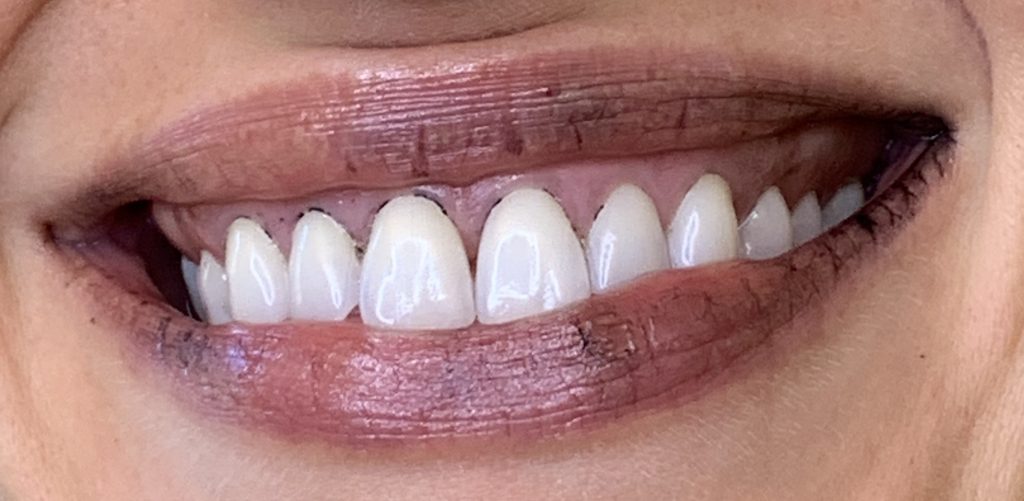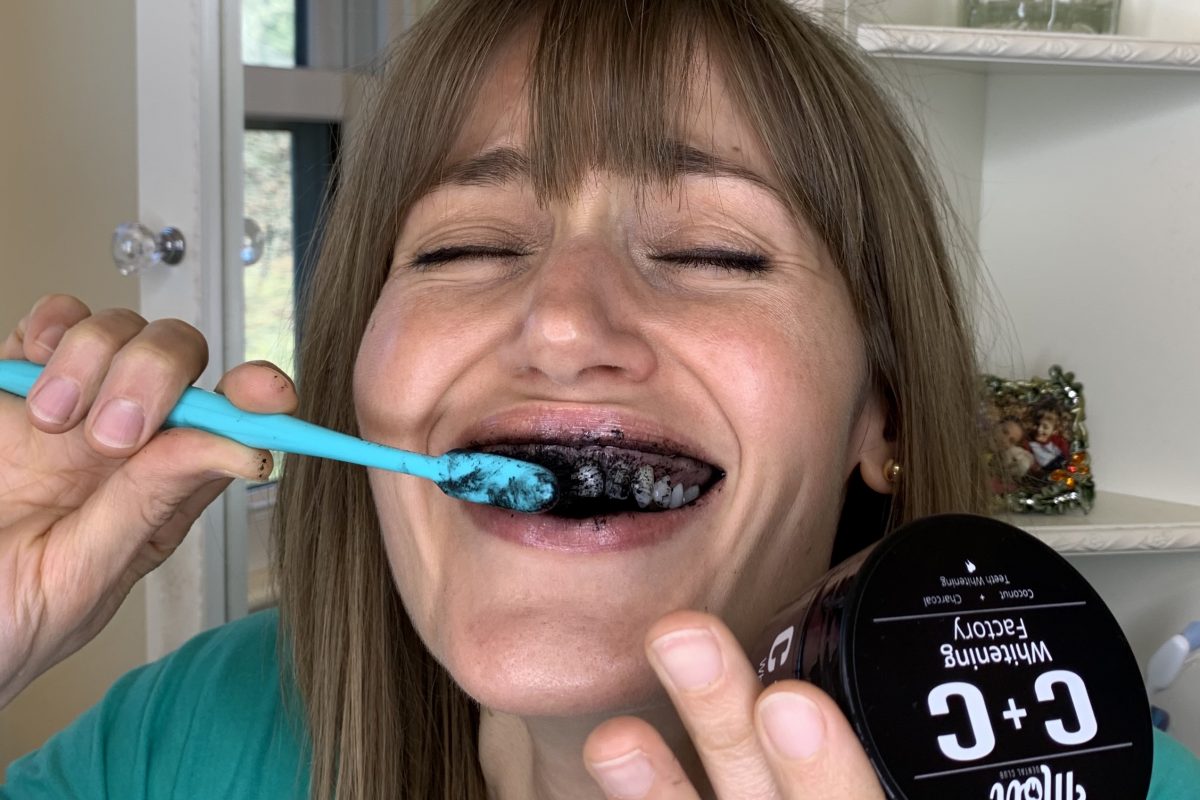Activated charcoal teeth whitening products. They’re out there… like, a lot! If you do a search for them on Amazon you’ll find over 2,000 results! It’s no wonder our patient’s are coming in en masse asking if they should be doing it, too, since everyone else they know already is! Personally, I thought it was just a quick blip that would pass relatively quickly in the dental world, yet here we still are. Even if you don’t actively go seeking it out, it seems to find you anyway. Some time ago, I even received some in my FabFitFun box subscription! So, what’s the 411 here? Do they actually work and are they safe?
Does Charcoal Work and is it Safe?
The idea behind activated charcoal is that it has a negative charge and it binds to things that have a positive charge. Hopefully, those positively charged things are the staining elements that darken teeth. (In my research, there was some vague eluding to the possibility of the negative charge of the charcoal binding to the positive charge of the calcium in your teeth and saliva, leaching the mineral from your teeth causing dental erosion; however, I think there’s no money to be had in doing this research so it doesn’t exist.) Sadly, there’s no concrete evidence demonstrating that it actually whitens teeth, although some observational studies suggest it can adsorb compounds that can stain the teeth. In my mind, charcoal whitening is now essentially lumped into the category of prevention instead of the treatment of darkening teeth.
There’s plenty of adventurous people out there who love to try new things (myself included!) and wouldn’t mind the staining prevention route but maybe you still have questions about its safety? Presently, the ADA (American Dental Association) has not approved any activated charcoal products in the field of dentistry. Well, now what?! Worry not, dear patients! General safety guidelines are here! We will now delve into the world of RDA, or Relative Dentin Abrasivity. (If you’re a numbers nerd this is your jam… if not, check back in later! =)
Safety Guidelines and RDA
Relative Denin Abrasivity is a guide to measure how abrasive a product is. Your toothpaste, for instance, should have a RDA of 200 or below (so sayeth the FDA). Your body has an amazing capacity to regenerate and heal itself with the exception of your teeth. Pretty much once it’s gone it’s gone. If you have a really abrasive toothpaste and you essentially scrub the outside layer of your teeth away, it’s not coming back.
A lot of whitening toothpastes have a higher RDA to scrub surface stains away, but it can be damaging to your teeth. The ADA has an RDA limit of 250 for certification of toothpaste even though the FDA places its upper limit at 200. Even an RDA of 200 is too high for me to use on a daily basis. You can google pretty much any toothpaste to find out its RDA value. Here’s the RDA scale:
Low: 0-70
Medium: 71-100
High: 101-150
Extremely High: 151-200
Activated charcoal has a general range of around 70-90. However, every company and every product is different. Unfortunately, the activated charcoal companies don’t make it easy to find this information out. I have either a) called or b) emailed companies inquiring about the RDA of their product. It may be low, it may be astronomically high… or they MAY NOT KNOW THEIR NUMBER! If this is the case, BEWAAAARRREE!! Please don’t put your one and only set of chompers on the line for a $10 charcoaling adventure! We would much prefer not to see your medical mishap online for things that could go wrong!
Beware!
What could go wrong you ask? For instance, the ADA says, “Using materials that are too abrasive on your teeth can actually make them look MORE yellow. Enamel is what you’re looking to whiten, but if you’re using a scrub that is too rough, you can actually wear it away. When that happens, the next layer of your tooth can become exposed – a softer, yellow tissue called dentin.” In other words, when the outer enamel is thinned and dentin is exposed, not only do your teeth appear more yellow, you also open up the possibility of having more sensitive teeth and are at higher risk for cavities. Not great.
One last idea worth mentioning about safety is the possibility of the powder form of activated charcoal potentially causing problems if you inhale it (cue the whispers of “carcinogen”). If you’re looking to use the powder form of it (as opposed to the already mixed toothpaste), it may be a challenge not breathing it in. The product that I tried was the powder form and WOW this stuff is crazy messy! I couldn’t even get through taking this picture without cracking up laughing at how it even blows in the “wind” in your house just opening the jar!
Still dedicated to the mission of dental charcoaling escapades after talking with us and reading all this? Here’s some tips:
Tips for Usage:
1) Choose a product with an acceptable RDA value
2) Pick a product made in the US or UK as they are less likely to have problematic ingredients
3) Opt for an already mixed product to lessen the chance of inhalation
4) Instead of brushing with it, only smear it on to let it do it’s work
5) Help replenish any Calcium that may have been lost from your teeth and saliva by enjoying some hard cheese, yogurt or milk
6) Make it a point to use it only occasionally to keep wear and tear to a minimum. No more than 1 time per week.
7) WEAR DARK CLOTHING! NEVER wear a white t-shirt (I learned that mass disaster the hard way! =)
8) Settle in for a nice, quiet evening with no guests! Don’t plan on a hot date afterward or an important business meeting as you may have some charcoal that gets lodged under your gums (see not cute post-pic!) as well as some crazy blueberry-eating-looking lips (kinda reminds me of Violet from Willy Wonka!).
What Would a Dental Hygienist Do?
In conclusion, there’s never a dull moment in dentistry! Over the years, I’ve had a handful of patient’s that have absolutely confounded me with their results contrary to exceptional science. You most likely will have a dud on your hands with charcoal. However, you may also be that one person in the extremely small percentile who has some pretty decent results! (And if so, please do share with us!) The safety and efficacy of activated charcoal has yet to be scientifically proven. Personally, I’m sticking to my tried and true bleach trays. (Whitestrips will provide results, too, if you’re looking to whiten without the moderate investment.) However, if the call of the intriguing and cool is beckoning you, HAPPY ADVENTURING! But above all and most importantly, cautiously, please!



